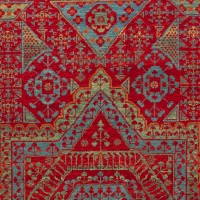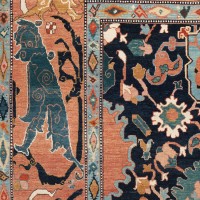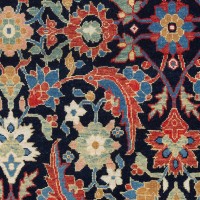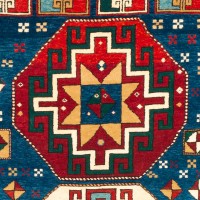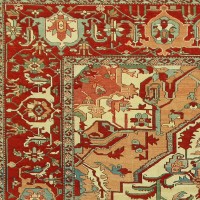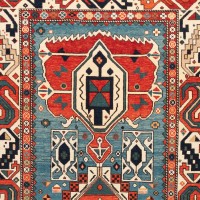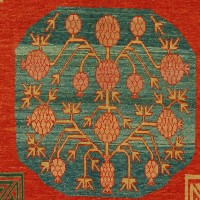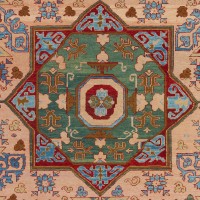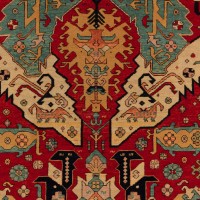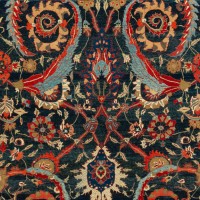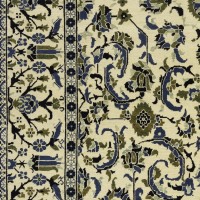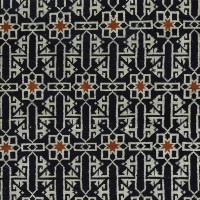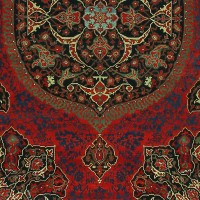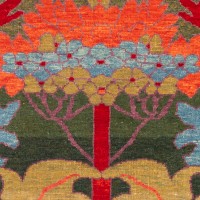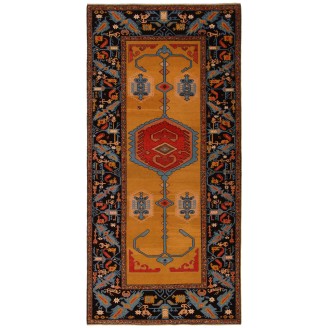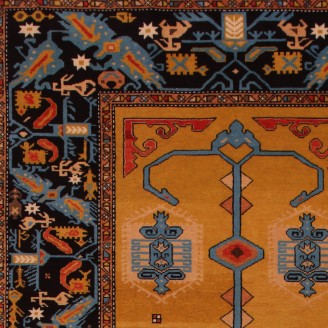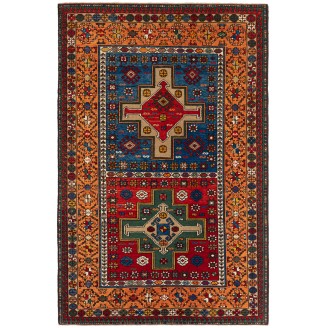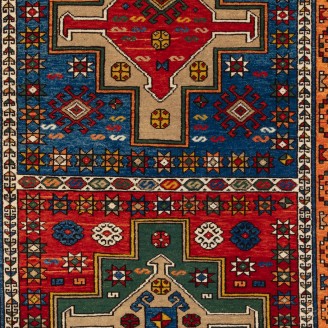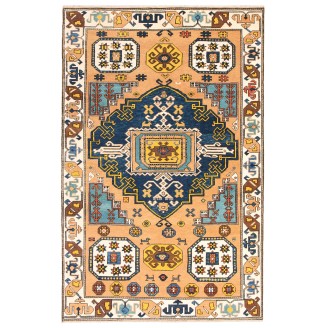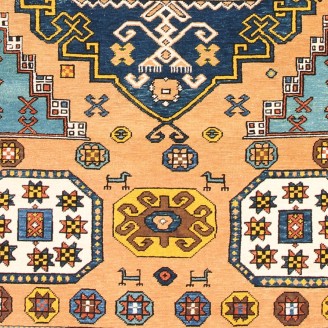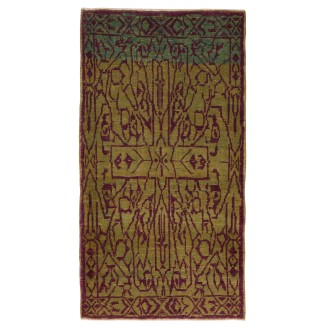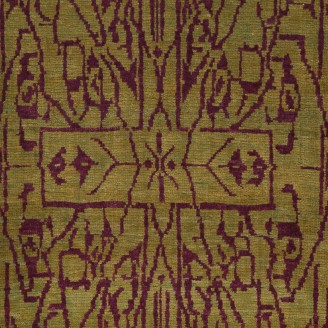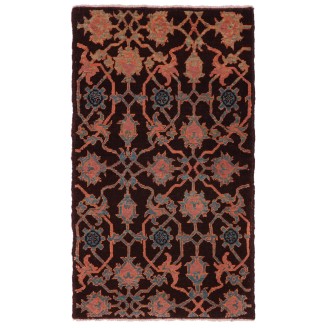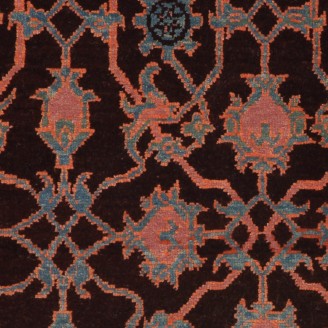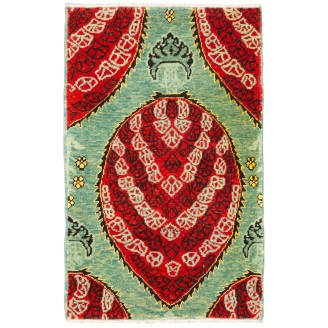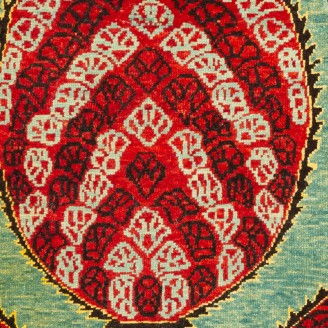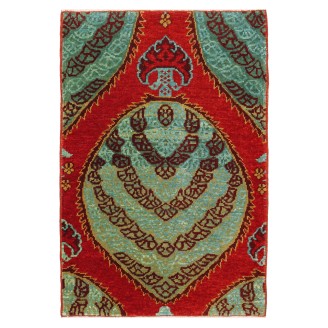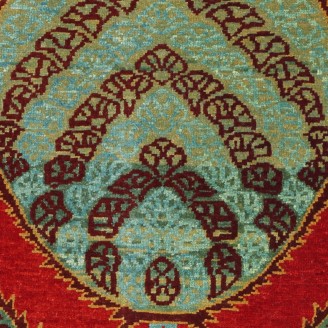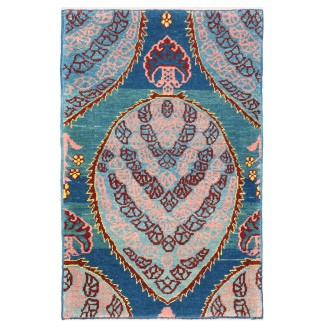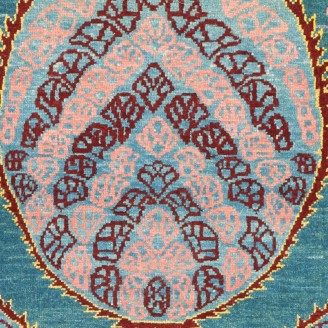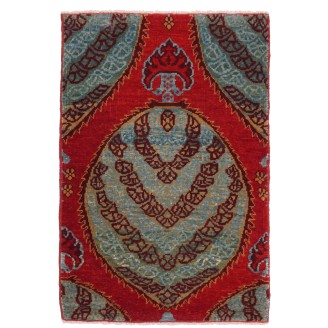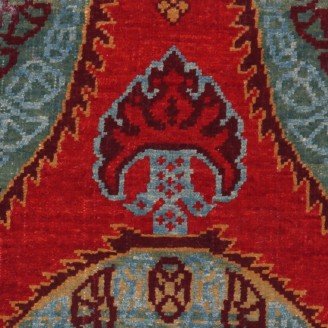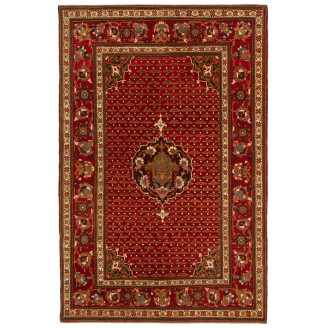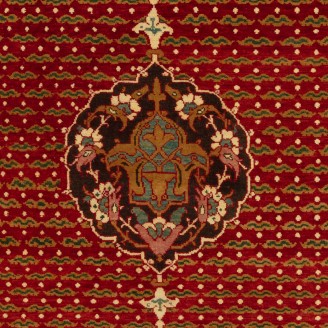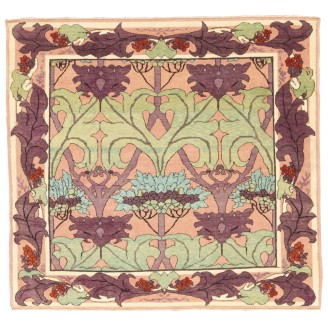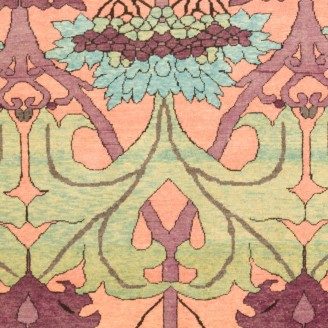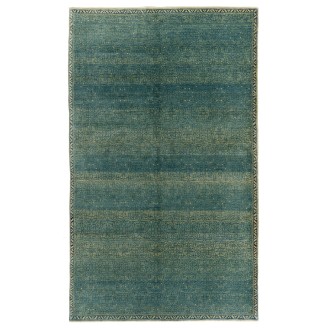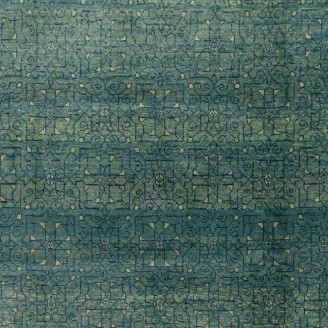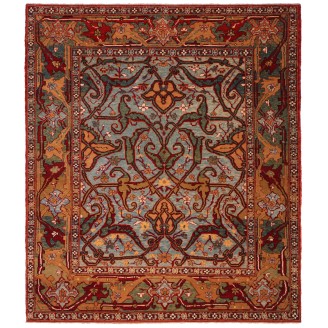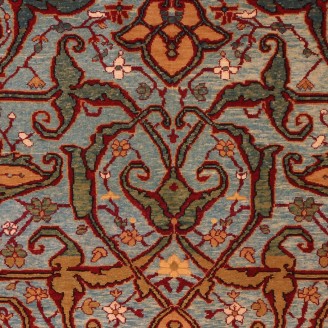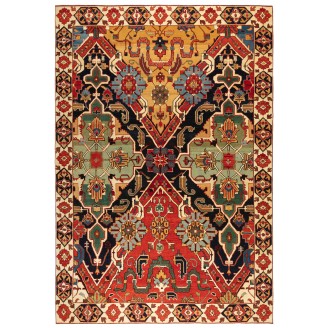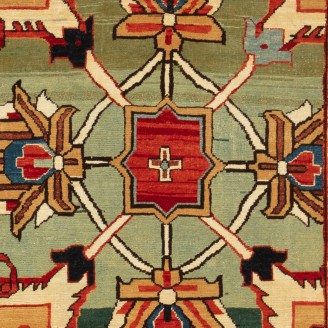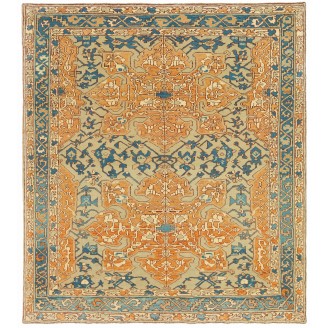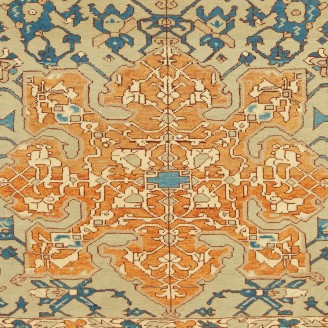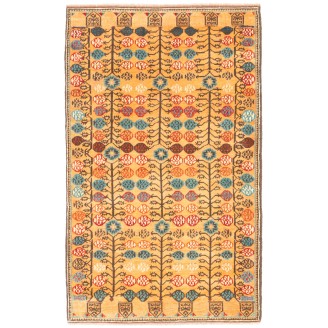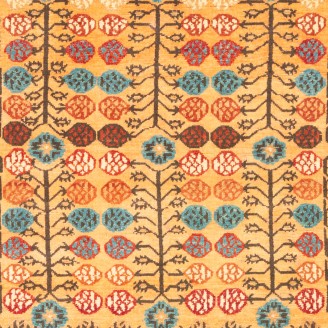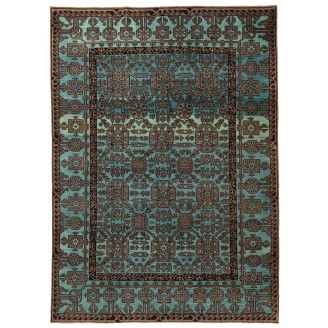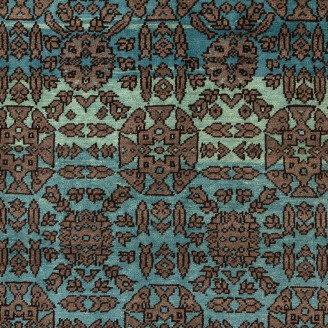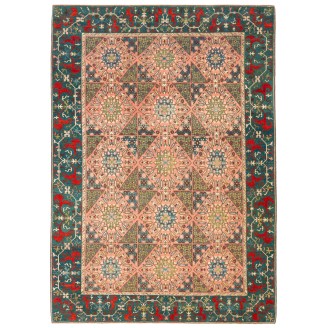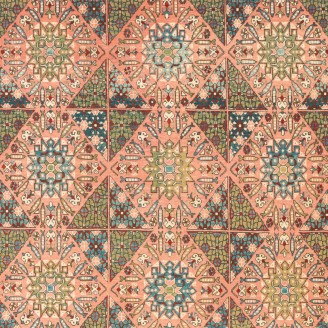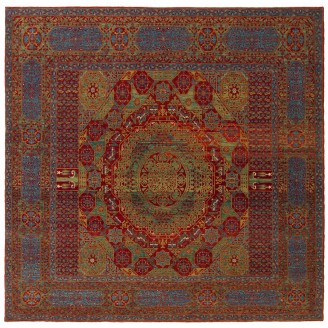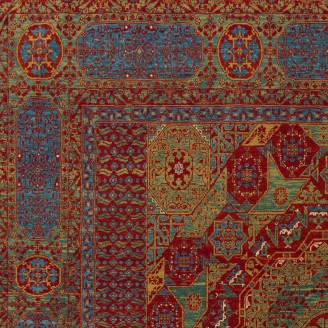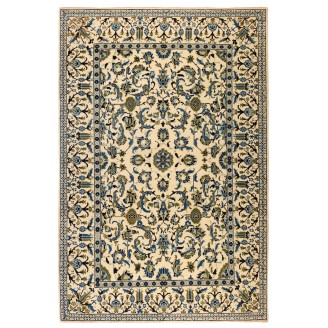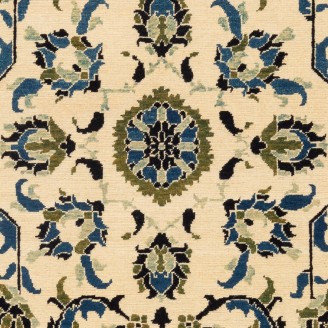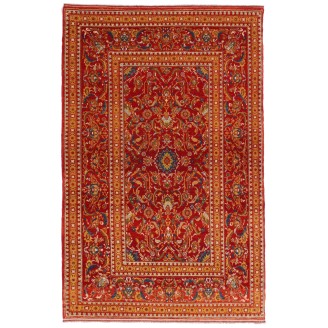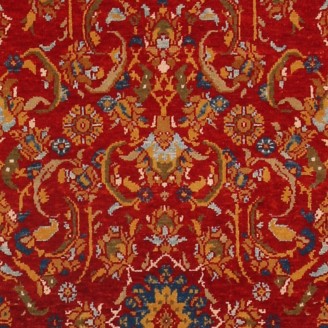Model: ART00366
Dimensions: 5'4" X 11'0"(164cm x 337cm)
The source of carpet comes from the book Orient Star - A Carpet Collection, E. Heinrich Kirchheim, Hali Publications Ltd, 1993 nr.198. This is a dramatic and unique field design 16th-century carpet from the Anatolia region, Turkey. According to this book; at the top of the vertical extensions from t..
Price:
$5,850
Ex Tax:$5,850
Model: ART00549
Dimensions: 4'9" X 7'2"(146cm x 220cm)
This is a Two Medallion Kagizman Kazak Rug, also known as Caucasian Kazak rug, is a type of handwoven rug that originated from the Kagizman region in northeastern Turkey, near the border with Armenia. These rugs are named after the Kazak tribes who traditionally wove them. Kagizman Kazak rugs are pa..
Price:
$3,600
Ex Tax:$3,600
Model: ART00317
Dimensions: 4'8" X 7'3"(144cm x 223cm)
The source of the rug comes from the book Orient Star - A Carpet Collection, E. Heinrich Kirchheim, Hali Publications Ltd, 1993 nr.160. This unusual shape of a central octagon and cross-shaped hooks in the diamond design 17th-century rug from the Central Anatolia area, Turkey. This rug's design is c..
Price:
$3,700
Ex Tax:$3,700
Model: ART00155
Dimensions: 1'8" X 3'1"(51cm x 95cm)
This geometric lattice pattern rug has the impression that it is only part of a larger scheme designed 15th-century rug from the Mamluk era, Cairo region, Eygpt. These designs have often been described as wagirehs or samplers and were said to have been used as weaver`s aids, or for demonstration pur..
Price:
$825
Ex Tax:$825
Model: ART00175
Dimensions: 1'8" X 2'9"(51cm x 85cm)
This rug has an interpreted design composed of a palmette lattice pattern taken from a part of the Mamluk rug, filling the field elegantly. These kinds of rugs have often been described as wagirehs or samplers and were said to have been used as weaver`s aids, or for demonstration purposes, made as a..
Price:
$825
Ex Tax:$825
Model: ART00177
Dimensions: 1'7" X 2'6"(50cm x 78cm)
The most dramatic of the Gerous ( Garrus, Gerus, Garus ) carpets are those with an "asymmetric" design. Only a section of the original is shown, in the same way, many Lotto carpets were woven. It is difficult to guess the size of these carpets from a photo, but here we enter the area of the "Wagireh..
Price:
$825
Ex Tax:$825
Model: ART00094
Dimensions: 1'7" X 2'5"(50cm x 75cm)
The most dramatic of the Gerous ( Garrus, Gerus, Garus ) carpets are those with an "asymmetric" design. Only a section of the original is shown, in the same way, many Lotto carpets were woven. It is difficult to guess the size of these carpets from a photo, but here we enter the area of the "Wagireh..
Price:
$825
Ex Tax:$825
Model: ART00154
Dimensions: 1'8" X 2'7"(51cm x 79cm)
The most dramatic of the Gerous ( Garrus, Gerus, Garus ) carpets are those with an "asymmetric" design. Only a section of the original is shown, in the same way, many Lotto carpets were woven. It is difficult to guess the size of these carpets from a photo, but here we enter the area of the "Wagireh..
Price:
$825
Ex Tax:$825
Model: ART00098
Dimensions: 1'7" X 2'6"(50cm x 77cm)
The most dramatic of the Gerous ( Garrus, Gerus, Garus ) carpets are those with an "asymmetric" design. Only a section of the original is shown, in the same way, many Lotto carpets were woven. It is difficult to guess the size of these carpets from a photo, but here we enter the area of the "Wagireh..
Price:
$825
Ex Tax:$825
Model: ART00565
Dimensions: 4'7" X 6'11"(140cm x 212cm)
Turkish Court Manufactury Rugs were woven in the Egyptian workshops founded by Ottoman Empire in the 16th century. Those carpets were woven in Egypt, following the paper cartoons probably created in Istanbul and sent to Cairo at that time.The design source of the carpet comes from the book by McMull..
Price:
$6,500
Ex Tax:$6,500
Model: ART00319
Dimensions: 5'0" X 4'7"(154cm x 140cm)
The source of the carpet comes from the book Arts & Crafts Carpets, by Malcolm Haslam, and David Black, 1991, fig.55. This Donegal carpet was possibly designed by the Silver Studio for Liberty's c.1902, United Kingdom. In 1887 English artist and bookbinder T.J. Cobden Sanderson, suggested that a..
Price:
$4,600
Ex Tax:$4,600
Model: ART00295
Dimensions: 5'7" X 9'1"(171cm x 279cm)
The source of the rug comes from the possession of Endre Unger, which was sold at Sotheby’s in 1992. That rug with the central star was designed in the early 16th-century rug by Mamluk Sultane of Cairo, Egypt. The interpreted design is composed of Jerrehian rug's border motifs lattice, covering the ..
Price:
$8,200
Ex Tax:$8,200
Model: ART00340
Dimensions: 4'10" X 5'6"(148cm x 168cm)
The source of the rug comes from the book Antique Rugs of Kurdistan A Historical Legacy of Woven Art, James D. Burns, 2002 nr.33. This is a fine Kurdish workshop rug with split-palmette and trefoil arabesque patterns designed mid-19th century rug from Senna or Garrus, Eastern Kurdistan area. This de..
Price:
$3,400
Ex Tax:$3,400
Model: ART00046
Dimensions: 8'4" X 12'1"(255cm x 370cm)
The source of the carpet comes from the book Islamic Carpets, Joseph V. McMullan, Near Eastern Art Research Center Inc., New York 1965 nr.41. This rug has become famous as the "Niğde Carpet." Although certainly produced in the Caucasus, it was found in the mosque of Niğde in Central Anatolia and was..
Price:
$27,300
Ex Tax:$27,300
Model: ART00413
Dimensions: 5'8" X 6'4"(175cm x 194cm)
The source of the carpet comes from the book How to Read – Islamic Carpets, Walter B. Denny, The Metropolitan Museum of Art, New York 2014 fig.46-47 and Oriental Rugs, Volume 4 Turkish, Kurt Zipper and Claudia Fritzsche, Antique Collectors' Club, 1989 nr.82. This 16th-century deeply serrated eight-l..
Price:
$3,900
Ex Tax:$3,900
Model: ART00404
Dimensions: 3'9" X 6'0"(115cm x 185cm)
This is a popular design employed by the Turks, a 17th-century rug from Turkey, Central Anatolia area. Stylized pomegranate trees with flowers and fruits, many diverse colored floral figures on an orange ground with both ends prayer arch (mihrab) design whose inner fields are covered with flowering ..
Price:
$2,400
Ex Tax:$2,400
Model: ART00351
Dimensions: 5'5" X 7'6"(167cm x 230cm)
The source of the carpet comes from the book Turkish Carpets from the 13th - 18th centuries, Ahmet Ertuğ, 1996 pl.9. This 13th-century carpet is from Ulu Mosque, Divrigi Sivas region, central Anatolia. The Seljuk period marks one of the highest points in art and architecture in carpets Anatolia. It ..
Price:
$4,600
Ex Tax:$4,600
Model: ART00360
Dimensions: 6'3" X 8'10"(192cm x 271cm)
The source of carpet comes from the book Islamic Carpets, Joseph V. McMullan, Near Eastern Art Research Center Inc., New York 1965 nr.28. The field of the so-called "Chessboard" Carpet ( so-called Checkerboard Rug ) is usually applied on a vermillion ground and divided into rectangular compartments,..
Price:
$13,800
Ex Tax:$13,800
Model: ART00551
Dimensions: 8'4" X 8'2"(256cm x 250cm)
The source of carpet comes from the book How to Read - Islamic Carpets, Walter B. Denny, The Metropolitan Museum of Art, New York 2014 fig.61,62. The five-star-medallion carpet was designed in the early 16th century by Mamluk Sultane of Cairo, Egypt. It is exhibited at The Metropolitan Museum of Art..
Price:
$16,500
Ex Tax:$16,500
Model: ART00203
Dimensions: 6'1" X 9'3"(187cm x 282cm)
Turkish Court Manufactury Rugs were woven in the Egyptian workshops founded by Ottoman Empire in the 16th century. Those carpets were woven in Egypt, following the paper cartoons probably created in Istanbul and sent to Cairo at that time. Shortly after its conquest by the Osmanli Turks (1517), a ch..
Price:
$8,700
Ex Tax:$8,700
Model: ART00284
Dimensions: 4'1" X 6'2"(125cm x 190cm)
Turkish Court Manufactury Rugs were woven in the Egyptian workshops founded by Ottoman Empire in the 16th century. Those carpets were woven in Egypt, following the paper cartoons probably created in Istanbul and sent to Cairo at that time. Shortly after its conquest by the Osmanli Turks (1517), a ch..
Price:
$4,100
Ex Tax:$4,100
